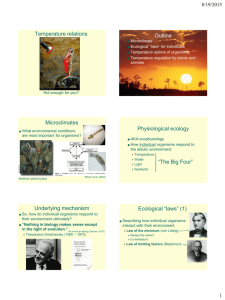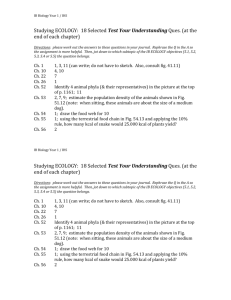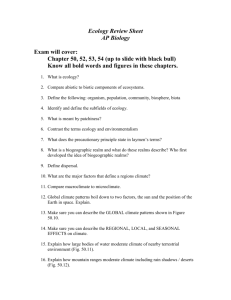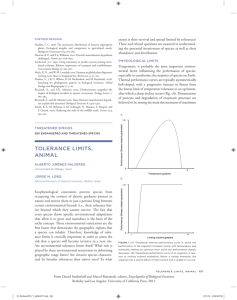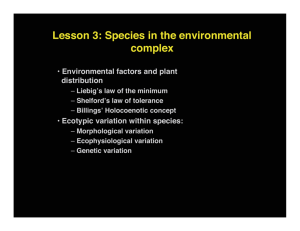General Ecology: Lecture 1
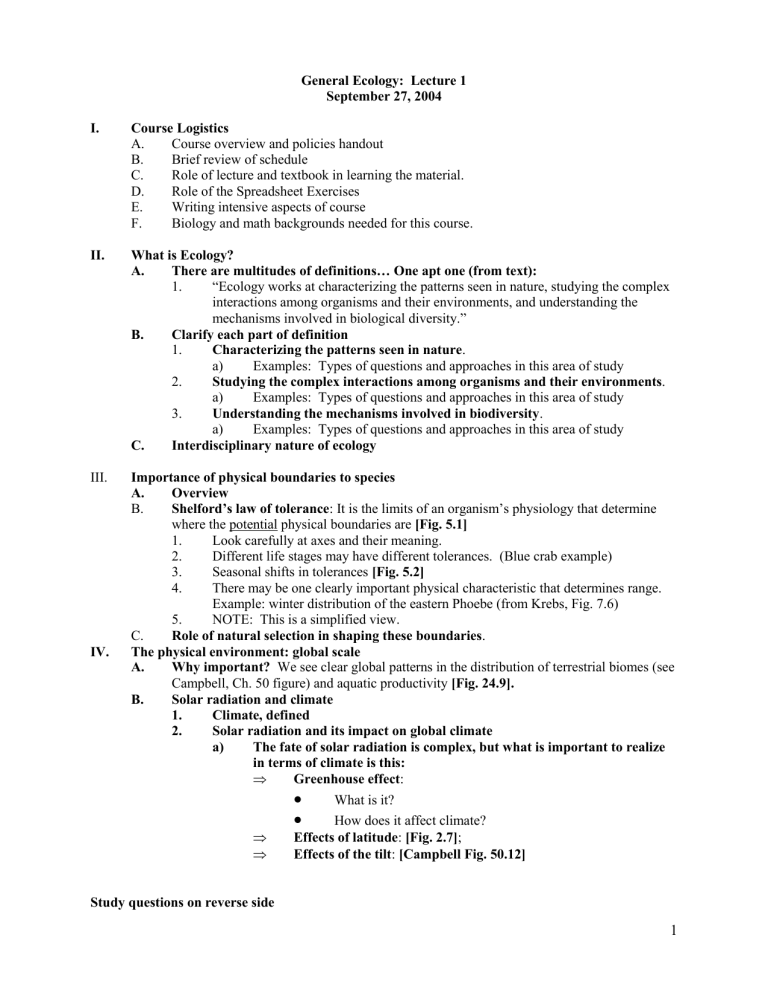
General Ecology: Lecture 1
September 27, 2004
I.
Course Logistics
A.
Course overview and policies handout
B.
Brief review of schedule
C.
Role of lecture and textbook in learning the material.
D.
Role of the Spreadsheet Exercises
E.
Writing intensive aspects of course
F.
Biology and math backgrounds needed for this course.
II.
What is Ecology?
A.
There are multitudes of definitions… One apt one (from text):
1.
“Ecology works at characterizing the patterns seen in nature, studying the complex interactions among organisms and their environments, and understanding the mechanisms involved in biological diversity.”
B.
Clarify each part of definition
1.
Characterizing the patterns seen in nature . a) Examples: Types of questions and approaches in this area of study
2.
Studying the complex interactions among organisms and their environments . a) Examples: Types of questions and approaches in this area of study
3.
Understanding the mechanisms involved in biodiversity . a) Examples: Types of questions and approaches in this area of study
C.
Interdisciplinary nature of ecology
III.
Importance of physical boundaries to species
A.
Overview
B.
Shelford’s law of tolerance : It is the limits of an organism’s physiology that determine where the potential physical boundaries are [Fig. 5.1]
1.
Look carefully at axes and their meaning.
2.
Different life stages may have different tolerances. (Blue crab example)
3.
Seasonal shifts in tolerances [Fig. 5.2]
4.
There may be one clearly important physical characteristic that determines range.
Example: winter distribution of the eastern Phoebe (from Krebs, Fig. 7.6)
5.
NOTE: This is a simplified view.
C.
Role of natural selection in shaping these boundaries .
IV.
The physical environment: global scale
A.
Why important? We see clear global patterns in the distribution of terrestrial biomes (see
Campbell, Ch. 50 figure) and aquatic productivity [Fig. 24.9].
B.
Solar radiation and climate
1.
Climate, defined
2.
Solar radiation and its impact on global climate a) The fate of solar radiation is complex, but what is important to realize in terms of climate is this:
Greenhouse effect :
What is it?
How does it affect climate?
Effects of latitude : [Fig. 2.7] ;
Effects of the tilt : [Campbell Fig. 50.12]
Study questions on reverse side
1
6.
7.
Study Questions
1.
Shelford’s law of tolerance: a.
Explain Shelford’s Law of Tolerance with words and diagrams. b.
What types of data go on the x-axis of a Shelford tolerance graph? What types of data go c.
on the y-axis of a Shelford tolerance graph?
How might you measure a “response of species” and what types of controls would you need to make sure you were only measuring response to the physical environment? d.
Try to come up with several “real” examples of organisms and the probable abiotic factor e.
that limits their geographical distribution. Think of several examples which appear to be regulated by different abiotic factors.
Are tolerances permanent and unchanging? Explain in terms of both individual organisms and the species as a whole.
Why is it important for biologists to study and understand global patterns in climate? 2.
3.
What physical factors, collectively, comprise a region’s climate? To help you understand this concept, compare the climates of any two geographic regions of your choice.
4.
What is (or what causes) the greenhouse effect, and how does it affect the earth’s climate? Why is it called the greenhouse effect?
5.
In one sentence, provide a simple explanation as to why are we concerned with the increases of greenhouse gases into the environment.
Explain what causes the intensity of solar radiation to be different at different latitudes.
What is the cause of the earth’s seasons? Use words and diagrams to explain your answer.
2
